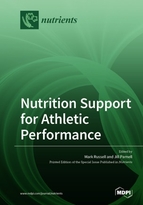Nutrition Support for Athletic Performance
A special issue of Nutrients (ISSN 2072-6643). This special issue belongs to the section "Sports Nutrition".
Deadline for manuscript submissions: closed (10 June 2019) | Viewed by 240465
Special Issue Editors
Interests: Match-day strategies to enhance the performance of team sports athletes, physiological and performance responses to intermittent exercise, the use of nutritional ergogenic aids for performance in team sports athletes
Interests: paralympic athletes; exercise-induced gastrointestinal symptoms; diet quality; dietary supplements; nutrition knowledge
Special Issues, Collections and Topics in MDPI journals
Special Issue Information
Dear Colleagues,
Athletes and their support personnel are constantly seeking evidence-informed recommendations to enhance athletic performances during competition and to optimize training-induced adaptations. Accordingly, nutritional and supplementation strategies are commonplace when seeking to achieve these aims, with such practices being implemented before, during, or after competition and/or training in a periodized manner. Performance nutrition is becoming increasingly specialized and needs to consider the diversity of athletes and the nature of the competitions. Nutrients, therefore, welcomes the submission of manuscripts, either describing original research or reviewing scientific literature, on the topic of nutrition support for athletic performance, which highlight recent advances in the discipline.
Prof. Mark Russell
Dr. Jill Parnell
Guest Editors
Manuscript Submission Information
Manuscripts should be submitted online at www.mdpi.com by registering and logging in to this website. Once you are registered, click here to go to the submission form. Manuscripts can be submitted until the deadline. All submissions that pass pre-check are peer-reviewed. Accepted papers will be published continuously in the journal (as soon as accepted) and will be listed together on the special issue website. Research articles, review articles as well as short communications are invited. For planned papers, a title and short abstract (about 100 words) can be sent to the Editorial Office for announcement on this website.
Submitted manuscripts should not have been published previously, nor be under consideration for publication elsewhere (except conference proceedings papers). All manuscripts are thoroughly refereed through a single-blind peer-review process. A guide for authors and other relevant information for submission of manuscripts is available on the Instructions for Authors page. Nutrients is an international peer-reviewed open access semimonthly journal published by MDPI.
Please visit the Instructions for Authors page before submitting a manuscript. The Article Processing Charge (APC) for publication in this open access journal is 2900 CHF (Swiss Francs). Submitted papers should be well formatted and use good English. Authors may use MDPI's English editing service prior to publication or during author revisions.
Keywords
- Performance nutrition
- Nutrient intakes for optimal performance
- Dietary supplements for health and performance
- Nutrition for specialized athletic populations
- Ergogenic strategies







